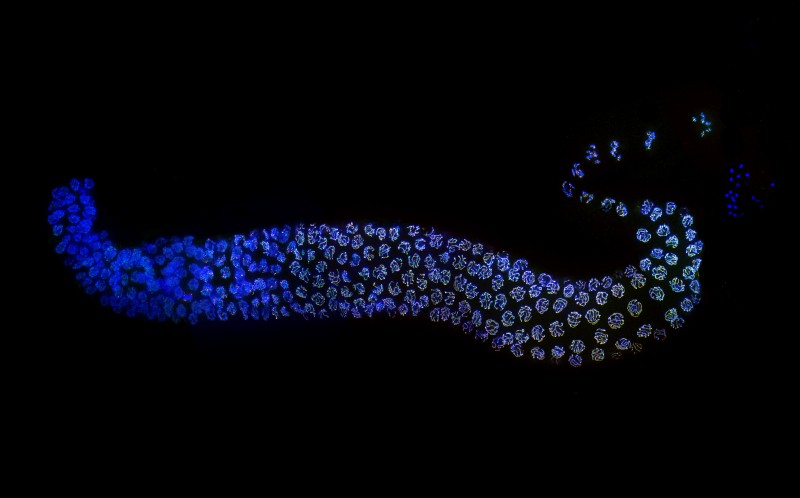By Sophie Arthur
June 27, 2018
Time to read: 2 minutes
Congratulations to Postdoc Sarai Pacheco Piñol from the Meiosis group who has won the Imperial Innovations Art of Research scientific image competition Judge’s Choice award for her image Gametogenesis in C. elegans: giving rise to new offspring, a snapshot of the process of meiosis on a nematode.
Sarai won the award following her image being shortlisted and chosen for display alongside 10 other images in the Art of Research exhibition at Imperial Festival.
Below is her image and explanation:

“Meiosis is a specialized cell division that generates haploid gametes to transfer the genetic information from parents to offspring. This is a unique process in which the number of chromosomes per cell is reduced by half allowing a diploid number of chromosomes to be restored at fertilization, being the cornerstone of sexual reproduction.
In the image, a germline of a hermaphrodite nematode Caenorhabditis elegans has been immunostained against the axial element protein HTP-3 (green), the central element SYP-1 (red) and DNA (blue) to monitor the process of synapsis of the chromosomes. The germline contains the meiotic nuclei ordered in a spatial-temporal gradient, so meiotic prophase is easily visualized. In the distal tip, germ cell nuclei undergo mitosis and move synchronously to the early stages of meiosis where homologous chromosomes start to synapse. Synapsis starts, when the axial elements (green) appear along each homologue. Once the homologous chromosomes have recognised each other, SYP proteins (red) glue them together forming the synaptonemal complex. Crossover recombination is then completed within the context of fully synapsed chromosomes. Finally, at diakinesis, six pairs of homologous chromosomes are observed held together by chiasmata, the cytological manifestation resulting of the crossover event. At the proximal end of the germline, sperm can be appreciated waiting to fertilize the mature oocyte.
Studies to understand the complete process of synapsis are important since defects in synaptonemal complex formation can cause meiosis failure leading to sterility and the formation of aneuploid gametes. These are the major causes for miscarriages and birth defects in humans”. – Sarai Pacheco Piñol
Interested in seeing more beautiful biomedical images? Then check out BPoD for a biomedical picture of the day.